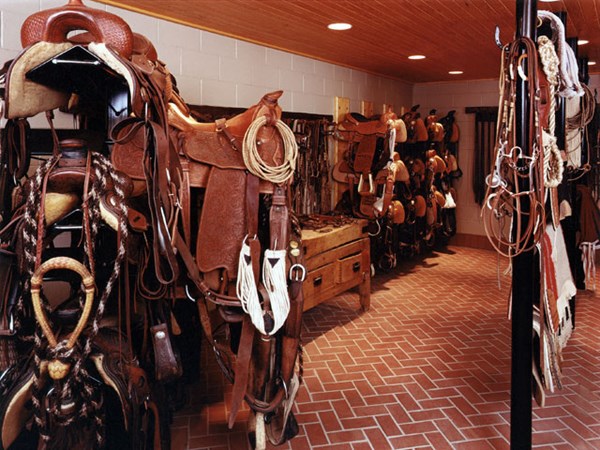
Keeping your barn organized can be a challenging task, especially for those that manage boarding and training farms; however, creating a plan and communicating that with clients and staff can help keep your barn tidier.
Norma Stein has ridden and owned horses for over 50 years. She started with hunters and transitioned to eventing, eventually spending most of her years in dressage. Now she thinks of herself as “a retired dressage rider who trail rides Western.” Over the years Stein has kept her horses on her own property, and she’s boarded at a variety of different facilities. She’s also been a barn manager as well as a groom for trainers.
Thinking back on her years of experience boarding at so many places that she enjoyed and with situations that benefited her horses, Stein shares some of the tips and ideas for making storage work effectively.
Tack Room Organization
”If you are building a barn or setting up a facility to be a boarding barn you should think about storage,” says Stein. “Probably the key storage need is where boarders will store their tack and equipment.” Consider whether you will use individual tack lockers, or if boarders will each provide their own tack trunk. “Some places even have a separate building or some type of place to put trunks or materials,” she says.
The storage needs of a barn often vary based on the discipline and whether the riders in the barn compete. “I think lockers are the ideal storage. You have a confined area which helps keep individuals from spreading out and overtaking their neighbor,” she explains. Lockers can be conveniently designed or built with saddle and bridle racks in them.
“A lot of facilities have numbered areas that correspond with their stall number,” shares Stein. “If your stall is number five, then in the tack room your locker will be number five. A separate saddle rack is also number five, as well as an individual bridle rack by the same number.” An open area for tack storage with no designated spaces can lead to severe disorganization and some riders might use more space than others. A room set up with bridle racks, saddle racks, and lockers that are all numbered means no clutter, and everyone has the same amount of space, says Stein.
Organizing Your Feed Room
“Everyone is going to have supplements for their horse,” says Stein. How the manager organizes their feeding program depends on the number of horses in the barn and their individual needs. Some barns might keep a horse’s supplements near their stall while others give each horse a labeled drawer or basket in the feed room. Be sure to keep feed and supplements in rodent-proof containers such as metal trashcans to minimize the risk of rodents contaminating the feed.
Especially if various staff members feed throughout the week, be sure that each horse’s feed and supplements are written out with the amounts and time of day to be fed to avoid feeding mistakes. If any horses need medication, be sure that is communicated clearly and written with the feeding instructions.
Storing Horse Blankets
“Blanket storage is perhaps the hardest part,” says Stein. “They (horse blankets) are so big and take up so much room. I think the best way is having hooks on walls, with numbers corresponding to the stall. You can have two blanket hooks per stall, or one hook with a second blanket kept on a stall door rack.”
“One barn I was at had a drying room for blankets,” comments Stein. A drying room is a heated room where you can hang wet blankets to dry. “They are a luxury, but in a wet climate you might need to think about that.”
During warmer seasons, when horses do not need to wear blankets, wash and fold the blankets to be stored in a loft or spare room, or consider having owners store their horse’s blankets if you do not have space in your barn.
The Barn Manager’s Role
“A lot of what a barn manager is going to be able to do depends on how wide the barn isles are,” says Stein. “For example, if the barn isle is narrow then you can’t have tack trucks sitting in front of stalls.”
The barn manager should take responsibility for keeping the barn clean and ensuring staff and clients understand organization protocol. Keeping the barn areas clear is part of fire safety, as well as rodent control (eliminating food clutter in the aisles can reduce rodents in the barn). “A person needs to be able to walk into and through a tack room, as well as walk horses down an aisleway without obstructions,” says Stein. In the end, these decisions are up to the barn manager who must inform boarders of limits and shared spaces and enforce the rules when necessary.
Take-Home Message
Taking the time to thoughtfully lay out storage plans is a wise investment that will make daily barn work simple and straightforward. Whether you are running a boarding facility or just trying to keep your own barn clutter free, organizing your barn will benefit you and your horses.
Editor’s Note: Click here to read more about how to safely store your hay!


